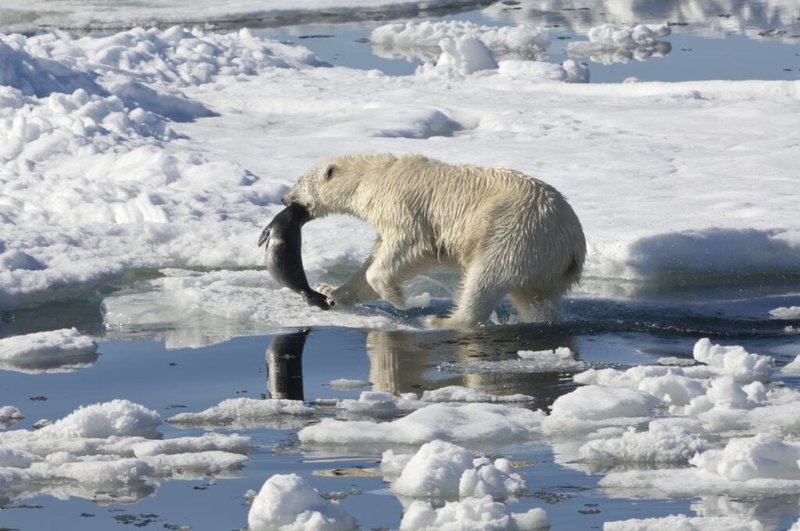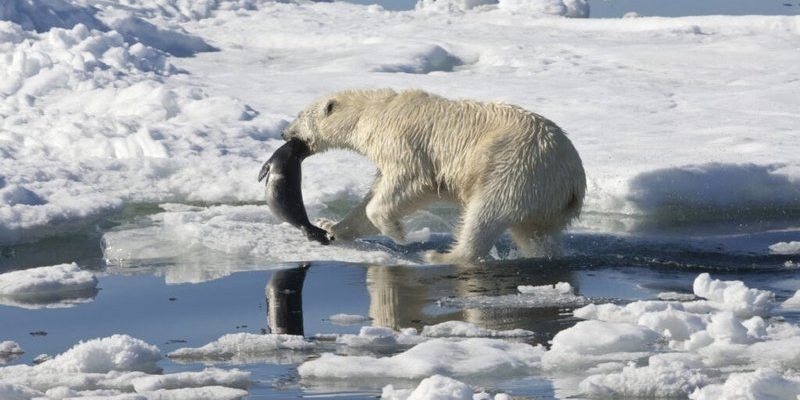
Imagine trying to feed yourself in a land where temperatures can drop to minus 40 degrees Fahrenheit. Polar bears have adapted uniquely to thrive in such conditions. Their diet mainly consists of seals, but it’s not just about what they eat; it’s about how they catch their food, too. It’s like they’re nature’s stealthy ninjas, using a mix of patience, strategy, and a keen sense of their environment.
Polar Bear Diet: The Basics
Polar bears are primarily carnivorous. Their main source of food comes from seals, particularly ringed seals and bearded seals. These seals are not just any ordinary snacks—they’re rich in fat, which is crucial for the polar bear’s survival in the frigid Arctic. The fat helps the bears maintain their body heat and provides energy during hunts.
Here’s how their diet works: in the wild, a single polar bear can consume up to 100 pounds of seal blubber in one sitting! This is no casual snack; it’s a feast that helps them store up fat for the leaner months. You might be wondering why they don’t just munch on anything they come across. The reality is that other food sources, like berries or terrestrial mammals, simply aren’t enough to fuel their high-energy lifestyle.
Interestingly, polar bears can fast for long periods. During the summer months when ice melts and seals are harder to catch, they can go without food for weeks or even months if necessary. This ability to adapt to food scarcity showcases how resilient they are, but it also highlights the impact of climate change on their hunting grounds.
How Polar Bears Hunt
Hunting isn’t just about charging at prey. Polar bears are skilled strategists. They often hunt seals by utilizing a method called “still-hunting,” which is all about patience and stealth. Here’s how it goes down:
1. Finding a Breathing Hole: Seals breathe through holes in the ice. Polar bears will search for these holes and position themselves quietly nearby.
2. Waiting: They can wait for hours, even days, to catch a glimpse of a seal surfacing for air. It’s like waiting for the perfect moment in a game; patience is key.
3. The Chase: Once a seal appears, the bear springs into action. With powerful paws that can run surprisingly fast, they make a quick dash, often surprising their prey.
This hunting strategy shows their cleverness. It’s not just about brute strength; it’s about using their intelligence to outsmart seals.
Seasonal Changes in Hunting Behavior
Interestingly, polar bears change their hunting strategies throughout the seasons. In winter and spring, when the ice is thick, seals are more abundant, and hunting is easier. Bears can roam vast territories and rely heavily on their keen sense of smell to detect seals beneath the ice.
As summer approaches and ice begins to melt, hunting becomes tougher. Bears might be forced to swim longer distances or even wander inland to find food. Here’s the thing: without stable sea ice, their hunting grounds diminish, making it harder for them to find that essential fat-rich food.
During these warmer months, polar bears also engage in what’s called “walking hibernation.” They slow down their activity to conserve energy, which helps them cope with the scarcity of food. It’s like a natural survival tactic, allowing them to make the most of their environment.
Adaptations for Hunting Success
Polar bears boast several adaptations that make them exceptional hunters. Their thick fur and a layer of fat help insulate them against icy temperatures. But let’s get into some specific traits that aid their hunting prowess:
– Sharp Claws: Their large, powerful paws are equipped with sharp claws that grip the ice, giving them stability when stalking seals.
– Keen Sense of Smell: A polar bear’s sense of smell is incredibly acute. They can detect a seal nearly a mile away or beneath several feet of compacted snow and ice.
– Excellent Swimmers: When ice is sparse, polar bears can swim long distances to hunt. Their powerful limbs allow them to navigate frigid waters with ease.
These adaptations show just how evolved polar bears are for life in the Arctic. Each characteristic contributes to their survival and hunting efficiency.
Human Impact on Polar Bear Hunting
With climate change and melting sea ice, polar bears are facing unprecedented challenges. The reduction in ice affects their hunting habits and the availability of seals. As a result, many polar bears are forced to travel further or expend more energy to find food. This not only affects their physical health but also their reproductive success.
Moreover, human activities, such as pollution and oil drilling, further threaten these majestic creatures. Chemicals can accumulate in the bears’ bodies, leading to health issues and reproductive problems. It’s a harsh reality that highlights the need for conservation efforts to protect their habitat and ensure their survival.
You might be wondering how you can help. Supporting organizations focused on climate change and wildlife conservation is a great start. Every little bit helps in protecting the future of these incredible animals.
Conservation Efforts and the Future of Polar Bears
Efforts to conserve polar bears are underway, but it requires global cooperation and commitment. Many organizations are working towards:
– Habitat Protection: Establishing protected areas to ensure bears have access to their hunting grounds.
– Climate Change Initiatives: Engaging in efforts to reduce carbon emissions, which contribute to global warming.
– Research and Education: Gathering data on polar bear populations to better understand their status and needs.
Conservation isn’t just about saving polar bears; it’s about maintaining the delicate balance of the Arctic ecosystem. The fate of these bears reflects the health of our planet, making it a shared responsibility for all of us.
In summary, the diet and hunting strategies of polar bears reveal not only their incredible adaptability but also the challenges they face in a changing world. By understanding these majestic creatures, we can appreciate their role in the ecosystem and the importance of protecting their habitat. Every action counts, and together, we can strive for a future where polar bears thrive in their natural environment.

